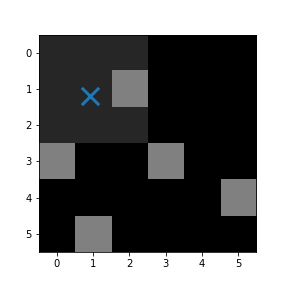Practice 7¶
Question 1¶
Follow the steps below to create a 3 x 5 numpy array representing the following data:
Use
np.linspaceornp.arangeto create three 1 x 5 arrays[0 1 2 3 4],[0. 1.5 3. 4.5 6.]and[0 0.25 0.5 0.75 1.].Use
np.zerosto create an 5 x 3 array of zeros.Use slicing to assign each 1 x 5 array to each row of the array.
Question 2¶
Use np.sum to create:
A 1 x 3 array containing the sum of the rows
A 1 x 5 array containing the sum of the columns
of the array created in Question 1.
Question 3¶
Write a function threshold(a, x) which thresholds the array a at the value x. The array returned be the function should be the same shape as a, and True where a greater or equal to x, otherwise False.
If q1 is the array from Question 1:
z = threshold(q1, 1.5)
print(z)
[[False False True True True]
[False True True True True]
[False False False False False]]
Question 4¶
The image file sixbysix.png (download) consists of a large but faint blob in the top left, and a number of small bright pixels elsewhere. Follow the particle tracking method in the notes to find and mark the large blob, as below.
Read the image into an array and reduce to greyscale
Threshold the array at a suitable value
Find all blobs in the image
Identify the largest blob
Determine the co-ordinates of the largest blob and

